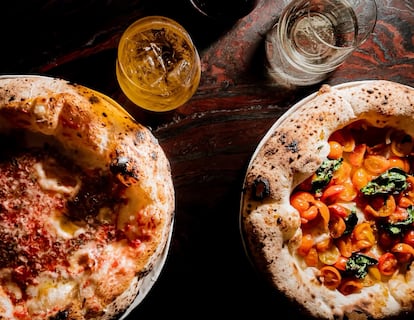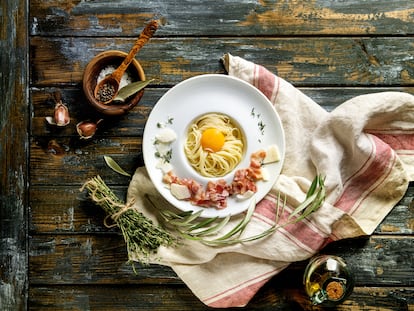The secret of the best pizza in the world is in New York
Chef Anthony Mangieri’s Una Pizza Napoletana on New York’s Lower East Side has won the coveted award two years in a row

Last September, the Top Pizza World ceremony was held at the Mercadante Theater in Naples, where the best pizza in the world was chosen. And for the second time, the winner did not hail from its Italian birthplace, but from a street in New York’s Lower East Side, in a medium-sized establishment called Una Pizza Napoletana. Its owner, Anthony Mangieri, thus beat Diego Vitagliano and Francesco Martucci to the honor, picking up the award for a second time after his 2022 triumph.
What is the secret of Una Pizza Napoletana? Well, the answer is in its very name. The concept “one” is essential to its success. It sounds simple, but it may be the most difficult aspect to maintain since Mangieri, 53, has stubbornly resisted the temptation to expand his business, despite the siren calls of investors. The vicissitudes of life led him to move from New Jersey to New York in 2004, and from there to San Francisco in 2010, but as of 2018 he has been based in Manhattan and he has never wanted to open a place without first closing the previous one. The reason is that he has a rule he is not willing to break for all the money in the world — and that is that no one but him is in charge of making the dough.

“If you go to see a band, you wouldn’t want to find other musicians doing covers of their songs, would you?” says Mangieri, who arrives at his restaurant at 9 a.m. to start kneading with his own hands, and closes up himself at 2 a.m., when everything is already clean and tidy. “The pizza changes a lot depending on the person making it. You and I could be kneading the same mixture and baking it in the same oven, but the result would be different, just because of the way we use our hands, how we distribute the tomato sauce, or the amount of cheese we put on it,” he says. To maintain this absolute control, the shop keeps embassy hours: it opens Thursday to Saturday from 5 p.m. and the last order is at 9.15 p.m. “We don’t refrigerate the dough, we keep it at room temperature. So it won’t even be the same pizza that you order at five as it is at six, seven, eight, or nine,” he says, breaking down the possibilities to an infinity in which he has been trapped for 38 years, since he was a teenager.

Despite coming from an Italian-American family in New Jersey, Mangieri’s relationship with pizza goes beyond the classic narrative. “My grandmother wasn’t a particularly good cook,” he jokes, referring to the use and abuse of the “della nonna” tagline in Italian restaurants. “I always thought that Italian-American food was a bit heavy, not as light as when I went to Italy. Devoting myself to pizza was also a way of digging into my identity, of finding myself,” he says. That search for origins permeates a menu in which Mangieri does not deviate from the seven pizzas on offer, on which he does not allow substitutions for any of the ingredients. There are the traditional marinara and margherita ($23 and $26, respectively), the bianca without tomato ($27), the cosacca (with peccorino romano, $24), the filetti (with cherry tomatoes, $28), and the special (which rotates weekly, and on the day of the interview was with salami, ricotta and taralli, at $32). No caviar or lobster pizzas, no French cheeses or truffle extracts. Where there is tomato sauce, buffalo mozzarella, basil and garlic, there is nothing else. “For me, innovation consists of these small micro-adjustments. Everything else has already been invented if you think about it, so all we have left is nuance,” explains the man who defines himself as “a pizza worker.”

Despite this humble statement, Mangieri is annoyed that pizza remains outside the culinary big leagues, perhaps weighed down by an excess of popularity. “There is still that hierarchy, unfortunately. The whole Michelin world still doesn’t recognize the world of pizza. They have given stars to a taco stand or ice cream parlors, but they still don’t consider any pizza maker worthy of that honour. I think they are not paying attention to what is happening,” he says. The Top Pizza World list for 2024 includes, for example, restaurants such as Tokyo’s The Pizza Bar on 38th, in third place, or, in eighth, Barcelona’s Sartoria Panatieri. “For a while I thought about getting closer to Michelin criteria, but then I realized that it will have to be the opposite: they will have to get closer to us,” he concludes. Indeed, for a time, he offered a more gourmet experience at a secluded table in his establishment, with off-menu options, and reservations skyrocketed. But he felt it distracted him from his usual pizzas. Now he is trying to pair his pizzas with Burgundy wines and champagne, a small flirtation with heterodoxy. But perhaps that working-class identity was what made him bet more strongly in 2022 on something closer to the people: a line of frozen pizzas called Genio della pizza. “I always insist that it is not the pizza we serve here, that it is a totally different experience. But I can say that it is the best frozen pizza you will find out there.”
Sign up for our weekly newsletter to get more English-language news coverage from EL PAÍS USA Edition
Tu suscripción se está usando en otro dispositivo
¿Quieres añadir otro usuario a tu suscripción?
Si continúas leyendo en este dispositivo, no se podrá leer en el otro.
FlechaTu suscripción se está usando en otro dispositivo y solo puedes acceder a EL PAÍS desde un dispositivo a la vez.
Si quieres compartir tu cuenta, cambia tu suscripción a la modalidad Premium, así podrás añadir otro usuario. Cada uno accederá con su propia cuenta de email, lo que os permitirá personalizar vuestra experiencia en EL PAÍS.
¿Tienes una suscripción de empresa? Accede aquí para contratar más cuentas.
En el caso de no saber quién está usando tu cuenta, te recomendamos cambiar tu contraseña aquí.
Si decides continuar compartiendo tu cuenta, este mensaje se mostrará en tu dispositivo y en el de la otra persona que está usando tu cuenta de forma indefinida, afectando a tu experiencia de lectura. Puedes consultar aquí los términos y condiciones de la suscripción digital.
More information
Archived In
Últimas noticias
Most viewed
- Sinaloa Cartel war is taking its toll on Los Chapitos
- Oona Chaplin: ‘I told James Cameron that I was living in a treehouse and starting a permaculture project with a friend’
- Reinhard Genzel, Nobel laureate in physics: ‘One-minute videos will never give you the truth’
- Why the price of coffee has skyrocketed: from Brazilian plantations to specialty coffee houses
- Silver prices are going crazy: This is what’s fueling the rally










































